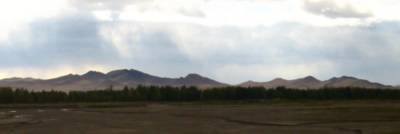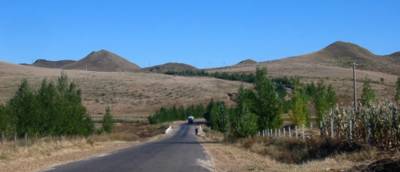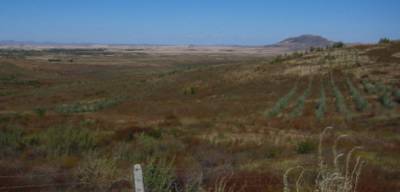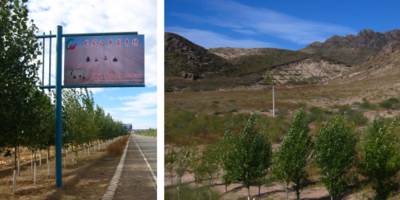distorted surface
desertification in chifeng league
even though I had come down from the more fragile highland ecosystem and had returned to the valleys of traditionally inhabited china, still I found some of the most striking evidence of warfare between the chinese authorities and the encroaching soil degradation here, in the mountainous area around chifeng.
not surprizingly, these valleys form the setting for bruce marcot's alarming story I read while planning the trip. even my pretty old aviation maps mention 'distorted surface'.
as mentioned earlier, the desertification situation on the highlands can be described as a battle at the forefront of chinese cultivation: a recently immigrated population of farmers tries to eek a living out of the land on the inner mongolian plateau. the struggle is tough, as the highlands are arid and cold, and yield marginal crops, while the soil is degrading and the sands are encroaching. both colonization (cardboard settlements, croplands, jaded tourist villages) and protection measures (trees and shrubs) are implemented in a linear pattern, lining the main arteries (highways, train tracks) across the highlands.
in the valleys of chifeng league, however, the problem seems to have an extra dimension. almost literally: lines becoming surfaces. in this once fertile area, squeezed in between the highlands and the coastal plains, the desertification problem is more structural. as more considerable short term losses in cropland are to be feared for the government, remediation measures have been equally more vast in comparison to what I saw on the highlands.
both disruption of the surface and remediation occurs on a vaster scale: huge sand dunes in the distance, dried out rivers, erosion of entire hillsides, valleys chockfull of saplings, huge areas of alternating strips of agricultural fields and protective trees. virutally everywhere in chifeng league, signs of china’s environmental warfare are visible.

sand dunes in the distance

dried out river

saplings

'reforested' valley
biking towards chifeng, thinking about national environmental policies for a country as big as china, about protection walls and inward looking dynasties, wondering whether man in fact can be stronger than nature, I realized mile by mile that combatting desertification in china doesn't equal trying to find a fragile balance between the forces of the environment and human occupation.
it means to fence off areas of economical accumulation, if possible steadily expanding them. it means affirmatively fighting the increasingly exhausted environment, unilaterally, wihtout negociation.

a sign announcing a completed tree planting project
even though they are green, the trees are as much part of the network of cultivation as railways, fences, factories. the trees are not intended to replace cleared forests, not even to help grasslands to recover (how would trees manage to do that anyway?), but to protect the human footprint on the grasslands they enclose.

the fence and the line of trees - loyal companions even in the dryest valleys

drought and depletion of fresh water resources by irrigation and overpumping cause more sandy areas as the topography drops (perspective difficult to grasp)
The main causes of the expansion of the desert in Inner Mongolia are overgrazing, deforestation, overcultivation and drought. As rainfall declines, water is being conserved on the upper reaches of the rivers for irrigation and aquifers are depleted by overpumping.
(from my initial article / june 03)

a roadside ad for sand dune entertainment (probably in a combo package with mongolian food) // checkerboard vegetation on an eroded hillside in the distance

a rough estimate: 85 percent of my 2600 kilometers I biked between two rows of trees.
Up to today, the question remains as to whether the area targeted by the wall is just too arid to support trees. And even if the trees take root, they'll soak up massive amounts of groundwater, which could worsen the problem.
According to environmentalists, Beijing has been largely content to issue proclamations about student-supported tree-planting and green Olympics rather than tackle complicated land uses. They want the government to foster positive behaviour – pay farmers to reduce livestock numbers, raise water prices to encourage conservation, and temporarily relocate locals away from arid areas to allow recovery. Ironically, it was the Chinese agricultural policy of the 1960s, actively populating Inner Mongolia with Han Chinese and encouraging nomadic Mongol shepherds to settle down, which started the assault on the ecology of the region.
(from my initial article / june 03)
even though I had come down from the more fragile highland ecosystem and had returned to the valleys of traditionally inhabited china, still I found some of the most striking evidence of warfare between the chinese authorities and the encroaching soil degradation here, in the mountainous area around chifeng.
not surprizingly, these valleys form the setting for bruce marcot's alarming story I read while planning the trip. even my pretty old aviation maps mention 'distorted surface'.
as mentioned earlier, the desertification situation on the highlands can be described as a battle at the forefront of chinese cultivation: a recently immigrated population of farmers tries to eek a living out of the land on the inner mongolian plateau. the struggle is tough, as the highlands are arid and cold, and yield marginal crops, while the soil is degrading and the sands are encroaching. both colonization (cardboard settlements, croplands, jaded tourist villages) and protection measures (trees and shrubs) are implemented in a linear pattern, lining the main arteries (highways, train tracks) across the highlands.
in the valleys of chifeng league, however, the problem seems to have an extra dimension. almost literally: lines becoming surfaces. in this once fertile area, squeezed in between the highlands and the coastal plains, the desertification problem is more structural. as more considerable short term losses in cropland are to be feared for the government, remediation measures have been equally more vast in comparison to what I saw on the highlands.
both disruption of the surface and remediation occurs on a vaster scale: huge sand dunes in the distance, dried out rivers, erosion of entire hillsides, valleys chockfull of saplings, huge areas of alternating strips of agricultural fields and protective trees. virutally everywhere in chifeng league, signs of china’s environmental warfare are visible.

sand dunes in the distance

dried out river

saplings

'reforested' valley
biking towards chifeng, thinking about national environmental policies for a country as big as china, about protection walls and inward looking dynasties, wondering whether man in fact can be stronger than nature, I realized mile by mile that combatting desertification in china doesn't equal trying to find a fragile balance between the forces of the environment and human occupation.
it means to fence off areas of economical accumulation, if possible steadily expanding them. it means affirmatively fighting the increasingly exhausted environment, unilaterally, wihtout negociation.

a sign announcing a completed tree planting project
even though they are green, the trees are as much part of the network of cultivation as railways, fences, factories. the trees are not intended to replace cleared forests, not even to help grasslands to recover (how would trees manage to do that anyway?), but to protect the human footprint on the grasslands they enclose.

the fence and the line of trees - loyal companions even in the dryest valleys

drought and depletion of fresh water resources by irrigation and overpumping cause more sandy areas as the topography drops (perspective difficult to grasp)
The main causes of the expansion of the desert in Inner Mongolia are overgrazing, deforestation, overcultivation and drought. As rainfall declines, water is being conserved on the upper reaches of the rivers for irrigation and aquifers are depleted by overpumping.
(from my initial article / june 03)

a roadside ad for sand dune entertainment (probably in a combo package with mongolian food) // checkerboard vegetation on an eroded hillside in the distance

a rough estimate: 85 percent of my 2600 kilometers I biked between two rows of trees.
Up to today, the question remains as to whether the area targeted by the wall is just too arid to support trees. And even if the trees take root, they'll soak up massive amounts of groundwater, which could worsen the problem.
According to environmentalists, Beijing has been largely content to issue proclamations about student-supported tree-planting and green Olympics rather than tackle complicated land uses. They want the government to foster positive behaviour – pay farmers to reduce livestock numbers, raise water prices to encourage conservation, and temporarily relocate locals away from arid areas to allow recovery. Ironically, it was the Chinese agricultural policy of the 1960s, actively populating Inner Mongolia with Han Chinese and encouraging nomadic Mongol shepherds to settle down, which started the assault on the ecology of the region.
(from my initial article / june 03)

<< Home